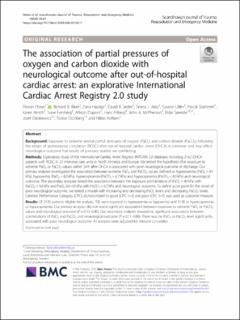| dc.contributor.author | Ebner, Florian | |
| dc.contributor.author | Riker, Richard R. | |
| dc.contributor.author | Haxhija, Zana | |
| dc.contributor.author | Seder, David B. | |
| dc.contributor.author | May, Teresa L. | |
| dc.contributor.author | Ullén, Susann | |
| dc.contributor.author | Stammet, Pascal | |
| dc.contributor.author | Hirsch, Karen G. | |
| dc.contributor.author | Forsberg, Sune | |
| dc.contributor.author | Dupont, Allison | |
| dc.contributor.author | Friberg, Hans | |
| dc.contributor.author | McPherson, John A. | |
| dc.contributor.author | Søreide, Eldar | |
| dc.contributor.author | Dankiewicz, Josef | |
| dc.contributor.author | Cronberg, Tobias | |
| dc.contributor.author | Nielsen, Niklas | |
| dc.date.accessioned | 2021-03-01T13:30:47Z | |
| dc.date.available | 2021-03-01T13:30:47Z | |
| dc.date.created | 2020-08-26T12:08:26Z | |
| dc.date.issued | 2020 | |
| dc.Published | Scandinavian Journal of Trauma, Resuscitation and Emergency Medicine. 2020, 28:67 1-9. | |
| dc.identifier.issn | 1757-7241 | |
| dc.identifier.uri | https://hdl.handle.net/11250/2730959 | |
| dc.description.abstract | Background
Exposure to extreme arterial partial pressures of oxygen (PaO2) and carbon dioxide (PaCO2) following the return of spontaneous circulation (ROSC) after out-of-hospital cardiac arrest (OHCA) is common and may affect neurological outcome but results of previous studies are conflicting.
Methods
Exploratory study of the International Cardiac Arrest Registry (INTCAR) 2.0 database, including 2162 OHCA patients with ROSC in 22 intensive care units in North America and Europe. We tested the hypothesis that exposure to extreme PaO2 or PaCO2 values within 24 h after OHCA is associated with poor neurological outcome at discharge. Our primary analyses investigated the association between extreme PaO2 and PaCO2 values, defined as hyperoxemia (PaO2 > 40 kPa), hypoxemia (PaO2 < 8.0 kPa), hypercapnemia (PaCO2 > 6.7 kPa) and hypocapnemia (PaCO2 < 4.0 kPa) and neurological outcome. The secondary analyses tested the association between the exposure combinations of PaO2 > 40 kPa with PaCO2 < 4.0 kPa and PaO2 8.0–40 kPa with PaCO2 > 6.7 kPa and neurological outcome. To define a cut point for the onset of poor neurological outcome, we tested a model with increasing and decreasing PaO2 levels and decreasing PaCO2 levels. Cerebral Performance Category (CPC), dichotomized to good (CPC 1–2) and poor (CPC 3–5) was used as outcome measure.
Results
Of 2135 patients eligible for analysis, 700 were exposed to hyperoxemia or hypoxemia and 1128 to hypercapnemia or hypocapnemia. Our primary analyses did not reveal significant associations between exposure to extreme PaO2 or PaCO2 values and neurological outcome (P = 0.13–0.49). Our secondary analyses showed no significant associations between combinations of PaO2 and PaCO2 and neurological outcome (P = 0.11–0.86). There was no PaO2 or PaCO2 level significantly associated with poor neurological outcome. All analyses were adjusted for relevant co-variates.
Conclusions
Exposure to extreme PaO2 or PaCO2 values in the first 24 h after OHCA was common, but not independently associated with neurological outcome at discharge. | en_US |
| dc.language.iso | eng | en_US |
| dc.publisher | BMC | en_US |
| dc.rights | Navngivelse 4.0 Internasjonal | * |
| dc.rights.uri | http://creativecommons.org/licenses/by/4.0/deed.no | * |
| dc.title | The association of partial pressures of oxygen and carbon dioxide with neurological outcome after out-of-hospital cardiac arrest: an explorative International Cardiac Arrest Registry 2.0 study | en_US |
| dc.type | Journal article | en_US |
| dc.type | Peer reviewed | en_US |
| dc.description.version | publishedVersion | en_US |
| dc.rights.holder | Copyright 2020 The Author(s). | en_US |
| dc.source.articlenumber | 67 | en_US |
| cristin.ispublished | true | |
| cristin.fulltext | original | |
| cristin.qualitycode | 1 | |
| dc.identifier.doi | 10.1186/s13049-020-00760-7 | |
| dc.identifier.cristin | 1825245 | |
| dc.source.journal | Scandinavian Journal of Trauma, Resuscitation and Emergency Medicine | en_US |
| dc.source.40 | 28:67 | |
| dc.identifier.citation | Scandinavian Journal of Trauma, Resuscitation and Emergency Medicine. 2020, 28, 67 | en_US |
| dc.source.volume | 28 | en_US |

